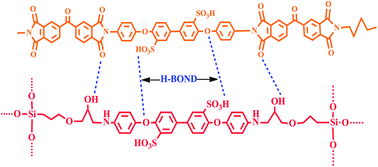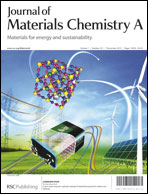Aliphatic-aromatic sulphonated polyimide and acid functionalized polysilsesquioxane composite membranes for fuel cell applications†
Abstract
For the design of highly stable and proton conductive polymer electrolyte membranes (PEM), we synthesized nucleophillic attack resistant sulphonated polyimide (SPI), in which electron-withdrawing sulphonic acid groups were not directly attached through amino-phenyl rings, using diamines with high basicity and dianhydride with low electron affinity. SPI- sulphonated silica precursor (SSP) composite PEM was assessed for its high water activity (water retention capacity) and direct methanol fuel cell (DMFC) applications. SPI/SSP-40 (composite membrane with 40 wt% SSP content) showed 10.25 × 10−8 cm2 s−1 water diffusion coefficient; 1.86 mequiv. per g ion-exchange capacity (IEC); and 6.34 × 10−2 S cm−1 proton conductivity. The prepared PEM was classified as water enriched because of the presence of a high percentage of bound water content. A relatively high proton mobility (5.52 × 10−4 cm2 s−1 V−1) across the PEM was attributed to a percolated network of ionic clusters (ions and water). Frictional data confirmed the reduction in frictional coefficient between the proton and membrane matrix at a high SSP content. The reported PEM, especially SPI/SSP-40, were assessed for their suitability for DMFC applications.


 Please wait while we load your content...
Please wait while we load your content...